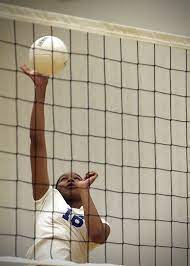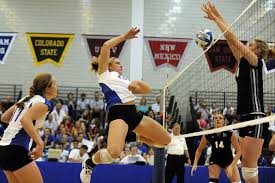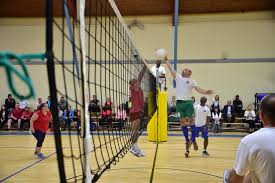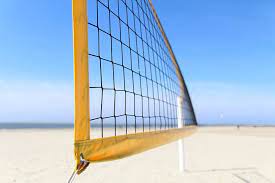| Table Header | Table Header | Table Header |
|---|---|---|
| Table Data | Table Data | Table Data |
| Table Data | Table Data | Table Data |
| Table Data | Table Data | Table Data |
| Table Data | Table Data | Table Data |
Knowing how high is a volleyball net is one the key factors that really matters in the exciting sport of volleyball. It’s a game-changer that affects how players play, strategies they use and overall attitude toward the sport; it’s more than just a technicality. In this article, let’s explore about how high is a volleyball net, why they are important, rules for various configurations, and how they affect the game.
What Is Meant by Volleyball Net Height
The height of the volleyball net is defined as the distance between the net’s center and the earth. It influences strategy and highlights player abilities, thus it’s more than just a technicality that affects how the game is played.
The Importance of Net Height in Volleyball
Beyond being merely a safety precaution, the net height has a significant effect on gameplay by controlling the ball’s trajectory and creating the ideal conditions for incredible spikes, blocks, and serves.

How High Is A Volleyball Net in Different Formats
Indoor Volleyball
Men’s Volleyball Net Heights
In indoor volleyball, the net height for men is standardized at 7 feet 11 5/8 inches (2.43 meters). This height is meticulously calculated to strike a balance between offensive and defensive strategies, ensuring an exciting and competitive game.
Women’s Volleyball Net Heights
For women’s indoor volleyball, the net height is slightly lower, set at 7 feet 4 1/4 inches (2.24 meters). This difference acknowledges the physical distinctions between men and women, providing a fair and enjoyable experience for all players.
Sitting Volleyball Net Heights
Sitting volleyball, designed for athletes with physical disabilities, has its own set of regulations. The net height for both men and women in sitting volleyball is standardized at 3 feet 9 1/4 inches (1.15 meters), facilitating an inclusive and accessible environment for players of all abilities.
Indoor Volleyball Net Heights for Younger Players
Youth Volleyball Net Heights
Recognizing the importance of catering to different age groups, youth volleyball has its own net height standards. For players aged 12 and under, the net height is set at 7 feet (2.13 meters). This ensures that young athletes can develop their skills in an environment tailored to their physical capabilities.
Middle School Volleyball Net Heights
As players progress to the middle school level (ages 13-14), the net height is adjusted to 7 feet 4 1/8 inches (2.24 meters). This gradual increase prepares them for the standard heights observed in high school and beyond.
Men’s Volleyball Net Heights
| Measurement at the center of the net | Measurement at the antenna | ||
| Standard | 7′ 11 5/8″ | 2.43 m | |
| Ages 55 to 69 | 7′ 9 5/8″ | 2.38 m | |
| Ages 70 plus | 7′ 6″ | 2.29 m |
Women’s Volleyball Net Heights
| Measurement at the center of the net | Measurement at the antenna | ||
| Standard | 7′ 4 1/8″ | 2.24 m | |
| Ages 45 plus | 7′ 2 1/8″ | 2.19 m |
Sitting Volleyball Net Heights
| Measurement at the center of the net | Measurement at the antenna | ||
| Men’s | 3′ 9.28″ | 1.15 m | |
| Women’s | 3′ 5.34″ | 1.05 m |
Youth Volleyball Net Heights
| Measurement at the center of the net | Measurement at the antenna | |
| Boys (Ages 10 and below) | 7′ | 2.13 m |
| Girls (Ages 10 and Below) | 6′ 6″ | 1.98 m |
| Boys and Girls(Ages 11 to 12) | 7′ | 2.13 m |
| Boys and Girls(Ages 13 to 14) | 7′ 4 1/8″ | 2.24 m |
| Boys (Ages 15 to 18) | 7′ 11 5/8″ | 2.43 m |
| Girls (Ages 15 to 18) | 7′ 4 1/8″ | 2.24 m |
Beach Volleyball Net Heights
| Measurement at the center of the net | Measurement at the antenna | |
| Men | 7′ 11 5/8″ | 2.43 m |
| Women | 7′ 4 1/8″ | 2.24 m |
| School/Youth/Junior | ||
| Boys and Girls(Ages 12 and below) | 6′ 7″ | 2.00 m |
| Boys and Girls (Ages 14 and below) | 6′ 11″ | 2.12 m |
| Boys and Girls (Ages 16 and below) | 7′ 4″ | 2.24 m |

Rules Regarding the Net Touch
Players must be cautious not to make contact with the net during play, as this can result in penalties. According to volleyball rules, a player is not allowed to touch the net with any part of their body or clothing while the ball is in play. Exceptions are made when a player’s follow-through from a legitimate play causes them to make incidental contact with the net.
If a player is found to have touched the net during a rally, the opposing team is awarded a point, and the serve is handed over to them. Additionally, if a player interferes with the net in a way that influences the course of play, it is considered a violation.
Violations and Penalties
Apart from net touches, there are other violations related to the net that can result in penalties. For instance, reaching over the net to block an opponent’s attack before the ball has crossed the net is not allowed. Doing so leads to a point awarded to the opposing team.
Repeated violations can result in more severe consequences, such as player disqualification or team penalties. It is crucial for players and coaches to be well-versed in the specific rules governing net play to avoid unnecessary penalties and maintain sportsmanship.
Choosing a Regulation Volleyball Net
Selecting the right net is vital for a seamless gameplay experience. Consider the following when choosing a regulation volleyball net:
- Material Quality: Look for nets made from durable and weather-resistant materials to withstand various playing conditions.
- Adjustability: Opt for nets with adjustable features, allowing you to fine-tune the height as needed.
- Compliance with Standards: Confirm that the chosen net complies with official regulations to avoid discrepancies during matches.
Tips for Measuring a Regulation Volleyball Net
Accurate measurement is crucial to maintaining the integrity of the game. Here are some tips for ensuring your volleyball net meets regulations:
- Use a Regulation Volleyball Net Gauge: Invest in a reliable gauge designed specifically for volleyball nets to guarantee precise measurements.
- Check Tension Regularly: Regularly inspect and adjust the tension of the net to ensure it complies with regulations.
- Level Playing Surface: Ensure the playing surface is level to maintain consistency in net height across the entire court.
Net Setup and Tension
Before the start of a volleyball match, ensuring the correct setup and tension of the net is vital. The net should be suspended firmly between the two posts, and the height should be verified using a measuring device. The tension of the net should be uniform throughout its length to prevent any sagging or unevenness.
Teams are allowed a specific amount of time for warm-up, during which they can adjust the tension of the net to their liking. However, once the match begins, any further adjustments are prohibited.
The construction of the net also plays a crucial role. It must be made of fine mesh, and the color should contrast with the surroundings to ensure visibility. The top and bottom edges must be reinforced with a band made of a contrasting color.
Impact of Volleyball Net Height on the Game
The dynamics of the game are significantly shaped by the height of the volleyball net. A taller net makes it necessary for players to leap higher and hit the ball more precisely, which gives the sport a more strategic and skill-based component. It also affects how well players block shots, which is important since it keeps the other team from scoring.

Adjustments of Volleyball Net Height for Different Skill Levels
Coaches may decide to change the net height in training and recreational environments to accommodate participants of varying skill levels. For beginners, lowering the net might help them gain confidence and skill before moving up to regular net heights. On the other hand, increasing the net puts more skilled players to the test, encouraging growth and refining their skills.
Conclusion
So, how high is a volleyball net, the height of the volleyball net is not just a set of standardized measurements; it is a fundamental aspect that shapes the dynamics of the game. From indoor to beach volleyball, and even specialized formats like sitting volleyball, the net height is carefully calibrated to balance the competitive nature of the sport.
Following the rules for net setup, tension, and player behavior is crucial to keeping the game fair. Coaches and players in volleyball must grasp the nuances of net height to ensure a level playing field for everyone, regardless of age or skill level.
How high is NCAA men’s volleyball net?
The NCAA men’s volleyball net is set at a height of 7 feet 11 5/8 inches (2.43 meters).
How high is the women’s net in USAV?
The women’s net height in USA Volleyball (USAV) is 7 feet 4 1/8 inches (2.24 meters).
Why is men’s volleyball net higher than women’s?
The net heights in men’s and women’s volleyball are different due to the physiological differences between men and women, particularly in terms of average height and jumping ability. The higher net in men’s volleyball (7 feet 11 5/8 inches or 2.43 meters) accommodates the generally taller stature and higher vertical jump of male players, promoting a balance between offense and defense. The net height in women’s volleyball (7 feet 4 1/8 inches or 2.24 meters) is set to suit the average height and jumping capabilities of female players, ensuring fair competition and maintaining the integrity of the game. These net height regulations aim to create a level playing field for both genders in their respective volleyball competitions.
How high should 7th grade girl volleyball net be?
The net height for 7th-grade girls’ volleyball is typically set at 7 feet 4 1/8 inches (2.24 meters). This standard net height ensures that the game is appropriately adapted to the physical abilities and skills of players at this age level.
Where should the net posts be placed in volleyball?
In volleyball, the net posts should be placed at the sidelines, with each post located 3 feet (0.91 meters) from the sideline. The net itself should be stretched taut between the posts and positioned directly above the centerline of the court. The center of the net should be 7 feet 4 1/8 inches (2.24 meters) high for women’s volleyball and 7 feet 11 5/8 inches (2.43 meters) high for men’s volleyball. The correct placement of the net posts ensures that the net is properly centered and the playing area is in accordance with official regulations.
